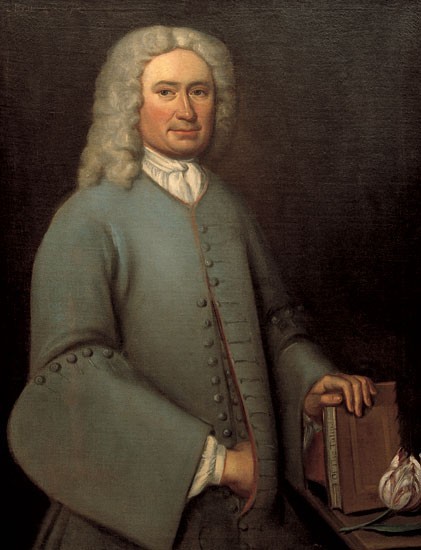
Charles Bridges, John Custis IV, 1725. Oil on canvas. 36" x 27". (Courtesy, Washington-Custis-Lee Collection, Washington and Lee University, Lexington, Virginia.)
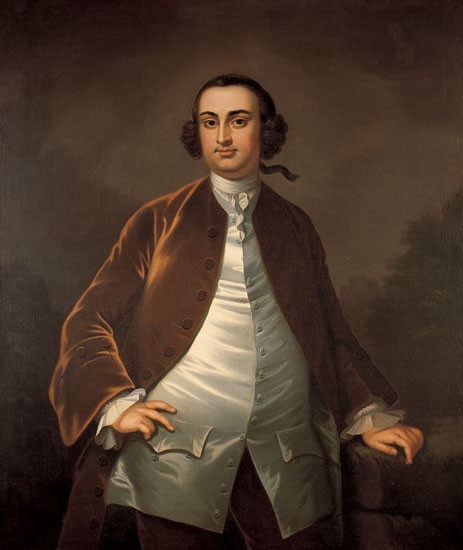
John Wollaston, Daniel Parke Custis, 1757. Oil on canvas. 50" x 40". (Courtesy, Washington-Custis-Lee Collection, Washington and Lee University, Lexington, Virginia.)

John Wollaston, Martha Dandridge Custis,1757. Oil on canvas. 50" x 40". (Courtesy, Washington-Custis-Lee Collection, Washington and Lee University, Lexington, Virginia.)
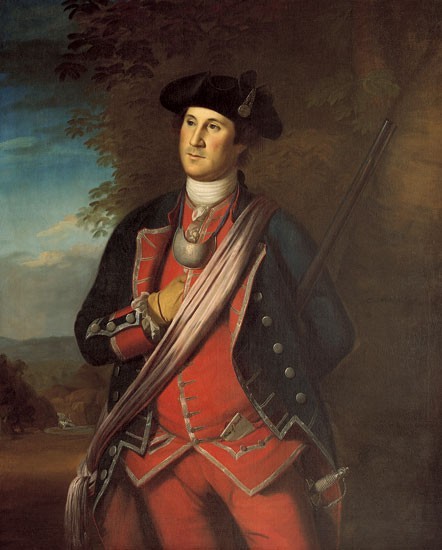
Charles Willson Peale, Washington as Colonel of the Virginia Regiment, 1772. Oil on canvas. 50 1/2" x 41 1/2". (Courtesy, Washington-Custis-Lee Collection, Washington and Lee University, Lexington, Virginia.)
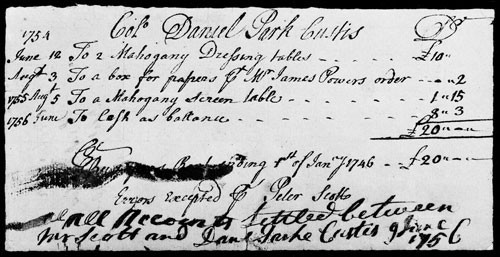
Invoice from Peter Scott of Williamsburg, Virginia, to Daniel Parke Custis of New Kent County, Virginia, for work done in 1754 and 1755, dated June 9, 1756. (Courtesy, Colonial Williamsburg Foundation; photo, Hans Lorenz.)
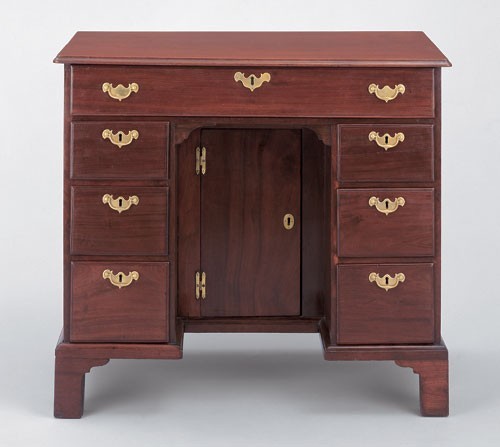
Peter Scott, bureau dressing table, Williamsburg, Virginia, 1754. Mahogany with oak and yellow pine. H. 32 5/16", W. 35 3/4", D. 19 3/4". (Courtesy, George Washington’s Mount Vernon, Mount Vernon, Virginia; photo, Hans Lorenz.) The missing brackets flanking the prospect door were replaced by Colonial Williamsburg conservators and are based on both physical evidence and surviving examples of other bureau dressing tables by Scott. The reproduction drawer hardware mimics the size of the missing originals. Its design was taken from hardware on other case furniture attributed to Scott. The feet and door hardware are original.
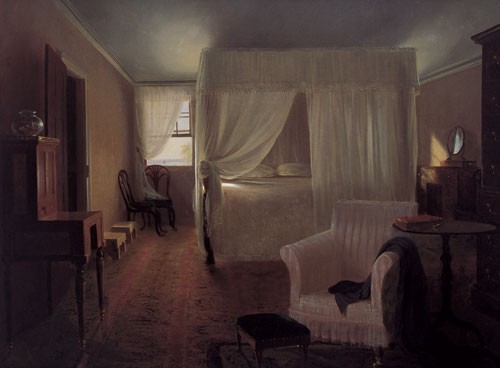
John Gadsby Chapman, The Chamber of Washington in which He Died with All the Furniture as It Was at the Time—Drawn on the Spot by Permission of Mrs. John Washington of Mount Vernon, 1835. Oil on canvas. 21 9/16" x 29". (Courtesy, Homeland Foundation, Incorporated, Amenia, New York.)
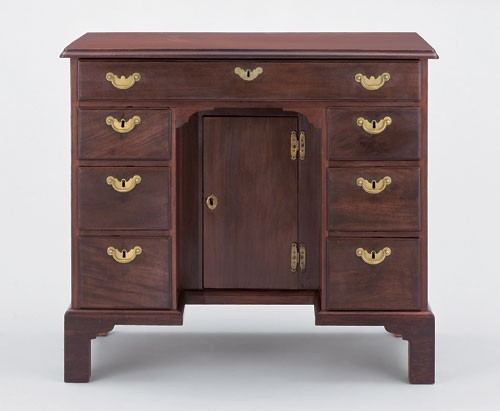
Bureau dressing table attributed to Peter Scott, Williamsburg, Virginia, 1745–1760. Mahogany with oak and yellow pine. H. 31 5/8", W. 36", D. 23 1/2". (Courtesy, Colonial Williamsburg Foundation; photo, Hans Lorenz.) The feet, top molding, and drawer hardware are recent restorations. The door hardware and one of the brackets are original.
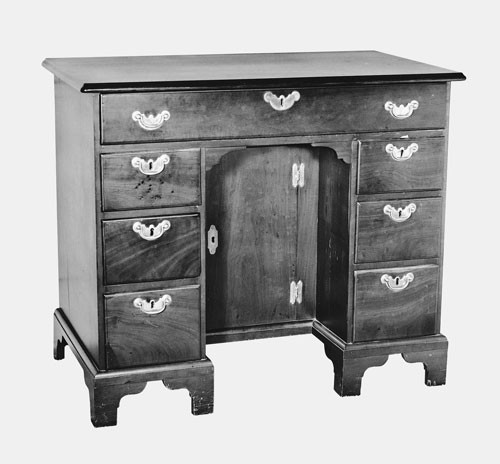
Bureau dressing table attributed to Peter Scott, Williamsburg, Virginia, 1745–1760. Mahogany with oak and yellow pine. H. 30 1/2", W. 36 1/4", D. 20 1/4". (Private collection; photo, Museum of Early Southern Decorative Arts, Old Salem Museums & Gardens.) The hardware, brackets, and base molding are original; the feet are old replacements.
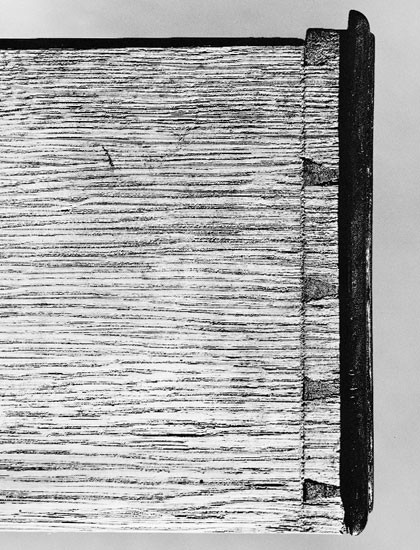
Detail of a drawer side from the bureau dressing table illustrated in fig. 6.

Detail of a drawer bottom from the bureau dressing table illustrated in fig. 6.

Detail of the dustboard construction on the bureau dressing table illustrated in fig. 8.
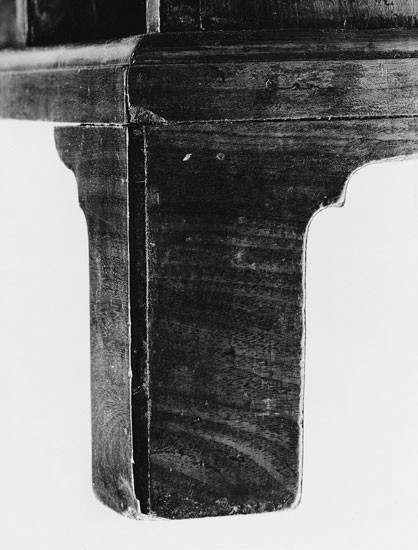
Detail of a bracket foot on the bureau dressing table illustrated in fig. 6.
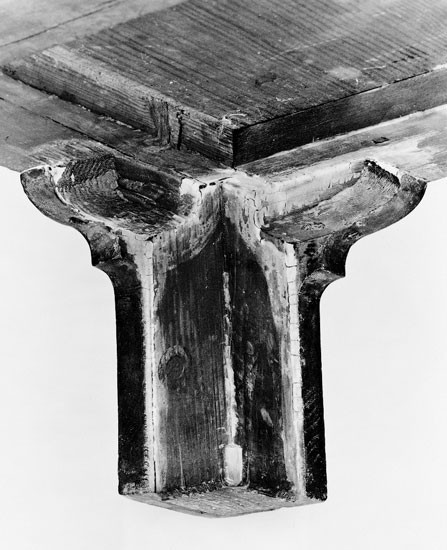
Detail of the original foot blocking on the bureau dressing table illustrated in fig. 6.
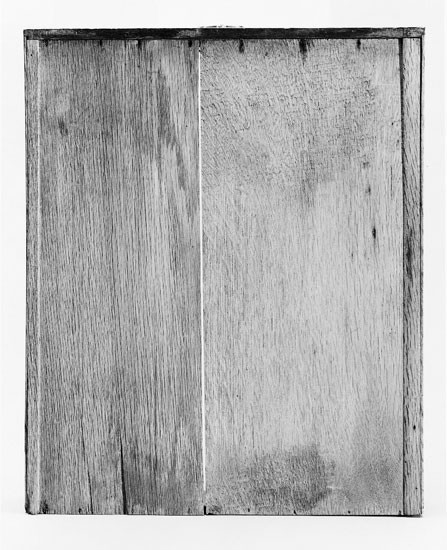
Detail of a drawer bottom from the desk-and-bookcase illustrated in fig. 16.
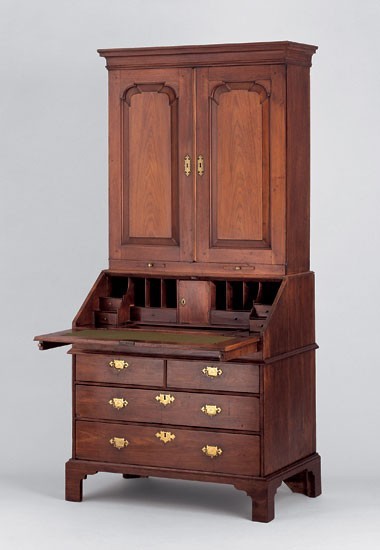
Desk-and-bookcase attributed to Peter Scott, Williamsburg, Virginia, 1722–1730. Black walnut and black walnut crossbanding with oak and yellow pine. H. 82 3/4", W. 39 3/8", D. 24". (Courtesy, College of William and Mary, gift of Caroline Baytop Sinclair; photo, Hans Lorenz.) The feet, base molding, and drawer hardware are inaccurate modern replacements. The surbase molding was replaced by Colonial Williamsburg conservators. The escutcheons and iron knife hinges on the bookcase doors are original.

Grace Coxed and Thomas Woster, desk-and-bookcase, London, England, 1719–1725. Burl maple and rosewood veneers with white metal inlays. Secondary woods and dimensions not recorded. (Adam Bowet and Laurie Lindey, “Labeled Furniture from the White Swan Workshop in St. Paul’s Churchyard [1711–35],” Furniture History 35 [2003]: fig. 15.) This piece bears the label used by the Coxed and Woster firm from 1719 to 1725. Its current location is unknown.
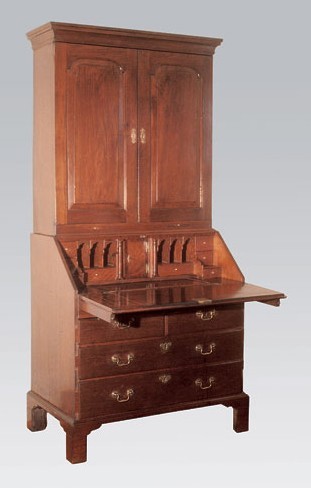
Desk-and-bookcase attributed to Peter Scott, Williamsburg, Virginia, circa 1735–1745. Black walnut and black walnut crossbanding with oak and yellow pine. H. 83 3/4", W. 41 1/4", D. 24". (Private collection; photo, Museum of Early Southern Decorative Arts, Old Salem Museums & Gardens.) The feet and the drawer escutcheons are original; the pulls are later replacements.
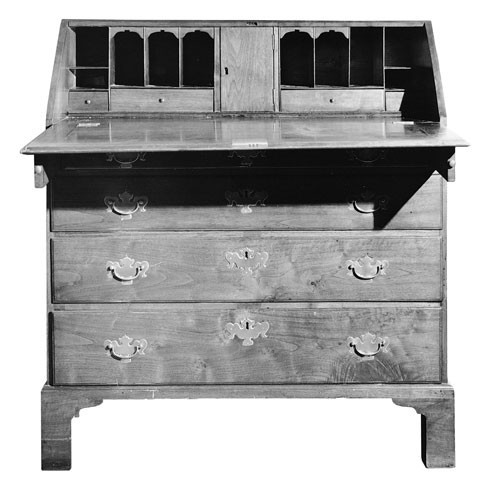
Desk attributed to Peter Scott, Williamsburg, Virginia, 1745–1755. Black walnut with oak and yellow pine. H. 42 1/2", W. 40", D. 20 7/8". (Private collection; photo, Museum of Early Southern Decorative Arts, Old Salem Museums & Gardens.) The feet are largely original; the drawer pulls and escutcheons are old replacements.

Desk-and-bookcase attributed to Peter Scott, Williamsburg, Virginia, 1745–1755. Black walnut and mahogany crossbanding with oak and yellow pine. H. 84", W. 42 1/8", D. 24 1/2". (Courtesy, Colonial Williamsburg Foundation; photo, Hans Lorenz.) The front feet and the drawer hardware are original.

Desk-and-bookcase attributed to Peter Scott, Williamsburg, Virginia, 1765–1775. Cherry with oak and yellow pine. H. 83 3/8", W. 41", D. 24". (Courtesy, Colonial Williamsburg Foundation; photo, Hans Lorenz.) The feet and the drawer hardware are recent replacements based on physical evidence and surviving examples of other case pieces attributed to Scott.

Desk-and-bookcase attributed to Peter Scott, Williamsburg, Virginia, 1765–1775. Black walnut with yellow pine. H. 83", W. 41 3/4", D. 24 1/4". (Private collection; photo, Museum of Early Southern Decorative Arts, Old Salem Museums & Gardens.) The drawer pulls and escutcheons are later replacements.
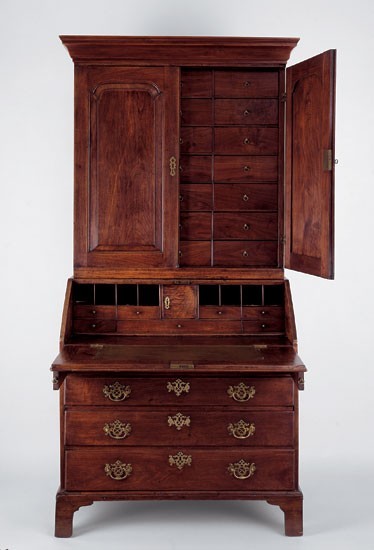
Desk and cabinet attributed to Peter Scott, Williamsburg, Virginia, 1750–1765. Black walnut with oak and yellow pine. H. 84 3/4", W. 40 1/2", D. 23 1/4". (Courtesy, Carlyle House Historic Park, Northern Virginia Regional Park Authority; photo, Gavin Ashworth.) In place of a standard bookcase, this desk is topped by a cabinet of small drawers behind paneled doors. The feet are partially restored; the hardware and cornice are recent replacements.
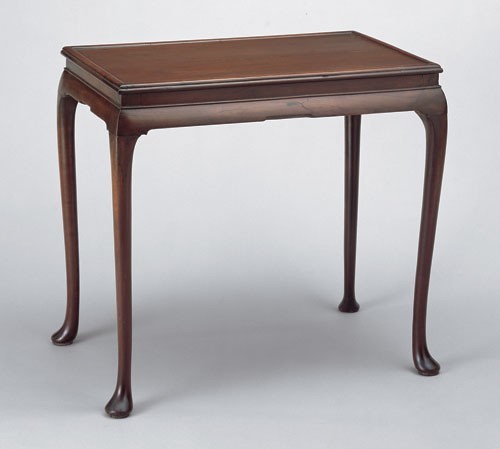
Tea table attributed to Peter Scott, Williamsburg, Virginia, 1722–1730. Mahogany with oak and yellow pine. H. 26 3/4", W. 29", D. 19 3/8". (Courtesy, Colonial Williamsburg Foundation; photo, Hans Lorenz.) The applied edge molding on the top is an early replacement.

Detail of the leg and foot on the tea table illustrated in fig. 24.
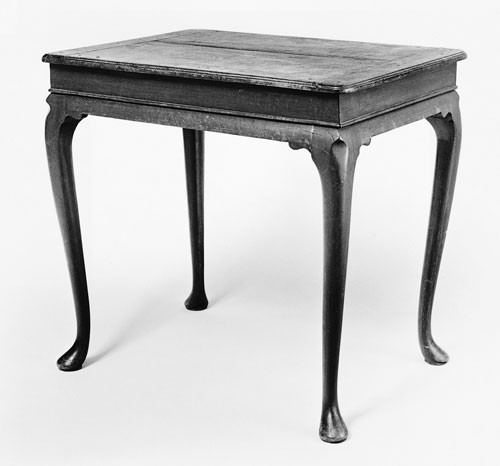
Tea table attributed to Peter Scott, Williamsburg, Virginia, 1730–1745. Black walnut. H. 25 3/16", W. 27", D. 20 1/16". (Private collection; photo, Museum of Early Southern Decorative Arts, Old Salem Museums & Gardens.) The top is an old replacement
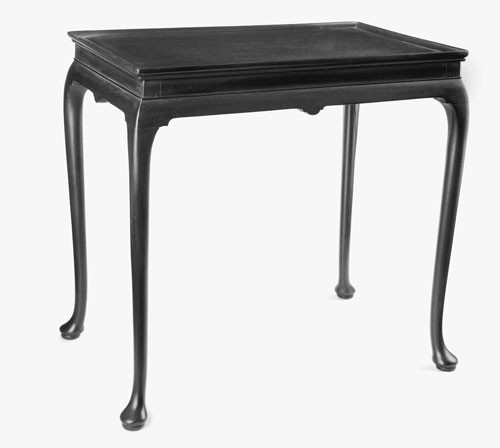
Tea table attributed to Peter Scott, Williamsburg, Virginia, 1745–1755. Mahogany with oak and yellow pine. H. 27 1/4", W. 29 5/8", D. 19 3/8". (Private collection; photo, Gavin Ashworth.)
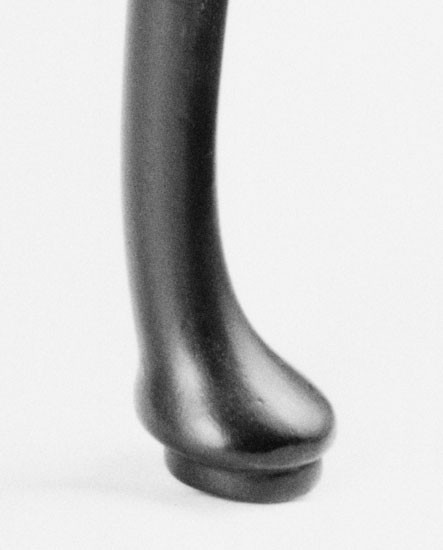
Detail of the leg and foot on the tea table illustrated in fig. 27.
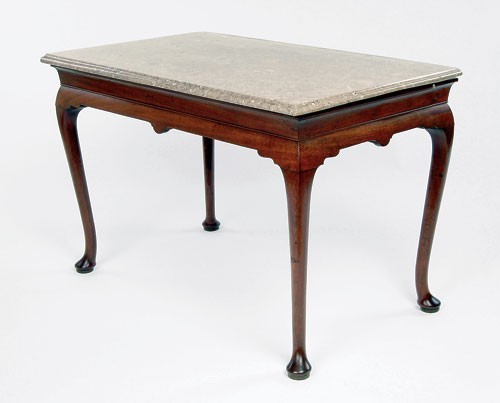
Sideboard table attributed to Peter Scott, Williamsburg, Virginia, 1745–1755. Black walnut with oak and yellow pine; marble top. H. 30", W. 44", D. 26". (Courtesy, Smithsonian Institution, National Museum of American History, Kenneth E. Behring Center.) The marble top is an old replacement.
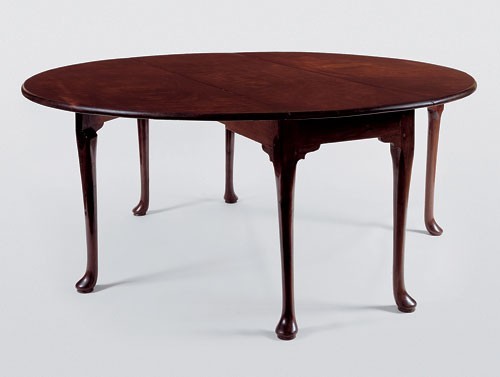
Dining table attributed to Peter Scott, Williamsburg, Virginia, 1722–1730. Mahogany with yellow pine and elm or hackberry. H. 28 3/4", W. 66 1/4", D. 71 1/4" (open). (Private collection; photo, Gavin Ashworth.) The table’s hinge rails are made of either elm or hackberry. These woods are seldom encountered in American furniture, but both were widely distributed through tidewater Virginia forests in the eighteenth century and both have many of the woodworking properties of oak.
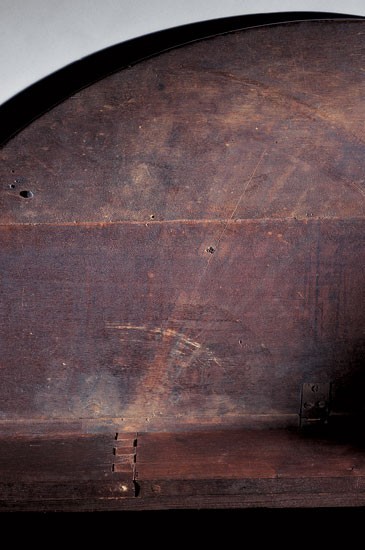
Detail of the pin on the underside of the dining table illustrated in fig. 32. Ony the stub of the pin survives.
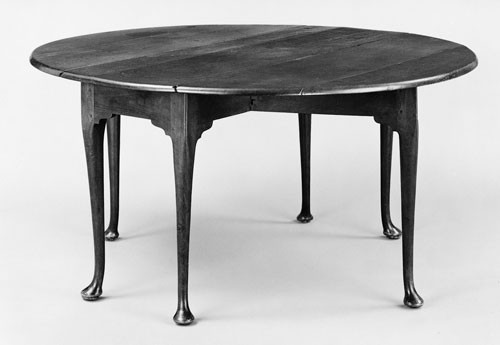
Dining table attributed to Peter Scott, Williamsburg, Virginia, 1745–1755. Black walnut with black walnut and yellow pine. H. 28 3/4", W. 60 3/4", D. 55 1/4" (open). (Courtesy, Colonial Williamsburg Foundation; photo, Hans Lorenz.)
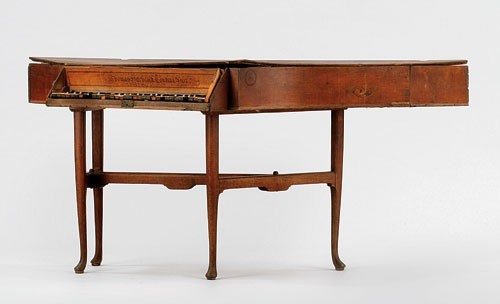
Thomas Hitchcock, spinet, London, England, ca. 1710. European walnut; unidentified conifer. Stand attributed to Peter Scott, Williamsburg, Virginia, 1725–1735. Black walnut. Dimensions of spinet and stand: H. 33 1/8", W. 72", D. 26". (Courtesy, Botetourt County Historical Society; photo, Hans Lorenz.) The lid, an early replacement made of American black walnut, may also be the work of Peter Scott.

Ceremonial chair attributed in part to Peter Scott, Williamsburg, Virginia, 1730–1740. Black walnut with tulip poplar and yellow pine. H. 97 1/2", W. 39 5/16", D. 26 3/8". (Courtesy, Commonwealth of Virginia on long-term loan to Colonial Williamsburg Foundation; photo, Hans Lorenz.)
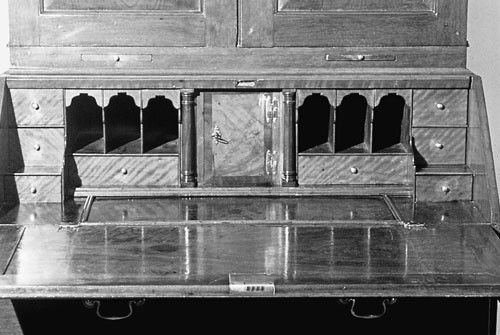
Detail of the writing compartment of the desk-and-bookcase illustrated in figure 18.
The study of an early cabinetmaker and his wares is often a long-term process of discovery and reconstruction. With the passage of time pieces of the artisan’s story inevitably have been lost or misplaced, and, in the process, the facts have been obscured. Telling documents such as account books commonly have been discarded, while invoices and receipts have been scattered. The most compelling evidence—the extant furniture—almost always has been removed from its original setting through successive sales or bequests. To re-create the artisan’s life and work, the historian consequently must track down the surviving pieces of information, reassemble them in proper sequence, and use informed assumption to fill in the gaps. Even when that work is seemingly completed, the prudent researcher knows that additional information may in time come to light and either reinforce or refute his or her findings. On occasion such unexpected discoveries lead to a complete departure from long-accepted conclusions. Such was the case in 2004, when new data surfaced regarding the work of Williamsburg, Virginia, cabinetmaker Peter Scott. This essay will present those findings and ascribe a new body of furniture to that artisan.
Scott and the furniture previously attributed to him first gained widespread attention among furniture historians and collectors in 1979 with the publication of Wallace Gusler’s breakthrough study, Furniture of Williamsburg and Eastern Virginia, 1710–1790. With his unmatched ability to reassemble historic shop groups through assessment of their ornamentation and structural details, Gusler recognized and then assigned to Scott a large and cohesive body of eighteenth-century Virginia furniture. Most of the more than twenty chairs, tables, and case pieces in that shop group still remain solidly united by their particular proportions, meticulous construction, and idiosyncratic carving, but questions have arisen over the years about their authorship and place of origin. Although these pieces are clearly the work of a single shop, virtually none of them was originally owned in or near Williamsburg. Instead, almost all of the known histories fall into the counties that flank Virginia’s Rappahannock River some seventy-five miles northwest of the colonial capital. As Robert Leath’s article in this volume of American Furniture reveals, most of the objects formerly attributed to Scott were, in fact, made in the vicinity of King George County, Virginia. New findings aside, however, the value of Gusler’s original research on Virginia furniture cannot be overestimated.[1]
Scott has often been described as the dean of Williamsburg cabinetmakers because of his personal and professional longevity. Born in Great Britain circa 1695, Scott resided in Williamsburg by 1722 and was still making furniture there in 1775, when the Virginia Gazette reported his death “in the 81st year of his age.” Neither Scott’s will nor his probate records survive to give indications of his material wealth, but regular patronage by the colony’s elite and his involvement in private transactions concerning substantial amounts of money suggest a high level of success. For example, in 1744 Scott held a mortgage of £31 against local resident William Keith, and ten years later he held another note for £105 on printer William Parks. In 1754 Scott loaned more than £100, representing roughly four years’ wages for a journeyman cabinetmaker, to physician Kenneth McKenzie. In 1765 Scott purchased the mortgage for a 250-acre tract from John Ferguson and then sold it a month later for a sum in excess of £150. Given the fact that less than half of the eighteenth-century court records for greater Williamsburg survive, it is likely that Scott was involved in a number of similar dealings over the years.[2]
Scott owned property on a back street in Williamsburg until at least 1755, but he rented his shop and perhaps his dwelling from the wealthy Custis family for forty-three years. Prominently located on busy Duke of Gloucester Street directly across from Virginia’s principal church, the shop was well situated for the furniture trade, since Scott’s neighbors were often other cabinetmakers. Scott’s first landlord, from 1733 to 1749, was planter and Williamsburg resident John Custis IV (1678–1749) (fig. 1). At Custis’s death the land and buildings passed to his son, Daniel Parke Custis (b. 1710) (fig. 2), and on the son’s unexpected death in 1757, the young man’s widow, Martha Dandridge Custis (1732–1802) (fig. 3) became Scott’s landlord. When she married George Washington (1732–1799) (fig. 4) two years later, he assumed direction of the property for his wife’s minor children, John Parke and Martha Parke Custis. In effect, Scott became the tenant of George Washington, a meticulous record keeper whose detailed accounts survive in large measure. As will be seen, this genealogical trail is a key element in the reassessment of Scott’s furniture. According to an original invoice in the Colonial Williamsburg collection, Scott provided “2 Mahogany Dressing tables” valued at £10 to Daniel Parke Custis in June 1754 (fig. 5). New research has shown that one of those tables survives and carries an impeccable record of ownership in the Custis and Washington families (fig. 6).[3]
After the initial reference in the invoice, both the surviving table and its mate appeared in the records again when Daniel Parke Custis died in 1757, just three years after taking delivery of the pieces. At that time the Custis executors prepared lengthy inventories of the assets of all the deceased’s various properties. The latter included his principal residence, White House Plantation in New Kent County, about twenty miles from Williamsburg; his late father’s still fully furnished Williamsburg house; and farms and plantations in several tidewater counties. The probate inventories for these holdings survive in the Washington papers and list virtually every standard eighteenth-century furniture form except the basic dressing table. However, the probate records do denote the presence of “2 Beauro dressing Tables” at White House Plantation, the same number supplied by Scott in 1754. The terms “dressing table,” “bureau dressing table,” and “bureau table” were used interchangeably in the eighteenth century to describe pieces of this form, with two columns of narrow drawers flanking a large, recessed prospect door.[4]
The Scott bureau dressing tables appear once again in records associated with the widow Custis’s 1759 marriage to George Washington. When Martha Washington moved to her new husband’s Mount Vernon Plantation in Fairfax County, Virginia, George prepared a list of the Custis assets his wife brought with her. Included were “2 Bureau dressing Tables” from White House Plantation. Once at Mount Vernon, Martha Washington used the bureau dressing table illustrated in figure 6 in her own chamber, and, following George’s death in 1799, the piece was listed in his estate inventory as the “Dressing Table” “In Mrs W__ns Old Room.” That this entry refers to the Scott bureau dressing table is confirmed by John Gadsby Chapman’s 1835 painting of the Mount Vernon bedchamber once shared by George and Martha Washington (fig. 7). Even though the contents of the room had long since been disbursed to the heirs, Chapman noted that he traveled to their various homes so that he could correctly record the appearance of each object and that granddaughter Eleanor Parke Custis Lewis instructed him on the furniture’s arrangement in the room. The bureau dressing table appears in the painting on the right side of the bed, topped by the dressing glass that family tradition also identifies as Martha Washington’s own.[5]
Following Martha Washington’s death in 1802, the bureau dressing table was taken to Tudor Place, the Georgetown, D.C., home of another granddaughter, Martha Parke Custis Peter (1777–1854), and her husband, Thomas Peter (b. 1769). Sometime before 1842, the Peters’ daughter, Britannia Wellington Peter (1815–1911), confirmed the table’s continued presence at Tudor Place when she wrote her name on its back. After more than 130 years at Tudor Place (which remained in family hands throughout the period), Martha Washington’s great-great-great-granddaughter Agnes Peter (1880–1957) returned the piece to Mount Vernon in 1937.[6]
Careful study of the structural and decorative details on the Custis-Washington bureau table has led to the discovery of twenty additional pieces made by the same hand. Of those with known histories, all but one were originally owned in or near Williamsburg, reinforcing the likelihood of local production. Fortunately for modern furniture historians, Scott was strikingly constant in both construction and decoration, making identification of his work comparatively simple. Among the objects discovered to date are three additional bureau dressing tables, all nearly identical to the Custis-Washington example. These include a table that carries an undocumented history of ownership by Patrick Henry (fig. 8) and an example that likely descended through the Harwood family of Williamsburg and adjacent York County to the Skinner family of North Carolina (fig. 9). A fourth, currently unlocated dressing table is known only from a photograph in a 1950 publication. All four tables feature the same drawer and door configuration, identically shaped brackets flanking their center openings, and quarter-round base moldings. The first three also have flat, unmolded prospect doors mounted on foliated brass hinges.[7]
Structurally the Custis-Washington, Henry, and Harwood-Skinner tables are markedly British, with most drawer sides and some drawer bottoms fabricated of thin, quarter-sawn oak in the English manner (fig. 10). Indeed, there is so much oak in these objects that in 1950 the Henry table was mistaken for an English import. Yellow pine drawer backs, case backs, and dustboards, however, confirm American production. The bottoms of the narrow side drawers are set into a rabbet and mounted flush with the lower edge of the drawer sides to form a smooth sliding surface (fig. 11). This approach is typical of case furniture made in London and other British urban centers from the 1670s to circa 1710. The drawers ride on dustboards that are the same thickness as the drawer blades, extend nearly the full depth of the case, and are set into dados cut into the case sides (fig. 12). Urban British artisans had generally abandoned such full-thickness dustboards in favor of thinner, stepped dustboards by the 1720s. These late-seventeenth- and early-eighteenth-century British details seem out of place on American furniture made in the 1750s, but they are consistent with Scott’s early British training, which, given his date of birth, must have occurred circa 1709–1716. His relocation to small and then relatively isolated Williamsburg by 1722 explains his decades-long failure to adopt newer construction details that became common in Britain in the years after his departure.[8]
Other standard British techniques evident on Scott’s bureau dressing tables include his use of a thin red wash to tone down the raw appearance of new secondary woods in the drawers and on the case backs. While only one of the four dressing tables—the Custis-Washington example—retains its original feet, these too are characteristic of those found on British case furniture of the 1720s. Of straight bracket form, the feet exhibit a visible butt joint on their secondary faces (fig. 13) and are backed with a vertically grained glue block that is square in cross section and flanked with a pair of shaped horizontal blocks (fig. 14).
Documents reveal that Scott made case forms other than bureau dressing tables. In September 1755 he advertised the sale of “sundry Pieces of Cabinet Work, of Mahogany and Walnut, consisting of Desks, [and] Book-Cases.” The same forms were mentioned in the advertisement of Scott’s estate sale in January 1776. Thomas Jefferson also recorded an order for “clothes presses to be made by Scott” in 1773 or 1774. To date no clothespresses have been discovered, but two of Scott’s desks and seven desk-and-bookcases have come to light, thanks in large part to the remarkable field research files at the Museum of Early Southern Decorative Arts. In all cases the desks exhibit the same dustboard construction seen in the bureau tables, identical quarter-round base moldings, and use of the red wash on secondary woods. Most of the surviving bracket feet match those on the Custis-Washington bureau table in both design and construction. Nearly all of the desks have drawer frames made of thin, quarter-sawn oak and all dovetails are identical in pattern to those of the drawers in the bureau tables. The construction of the large drawers differs in only one respect: to accommodate the greater width of the desk drawers, Scott used one-piece strips of wood along each side of the bottom. As figure 15 shows, these strips are recessed to remain flush with the lower edge of the drawer side. This detail also appears on the wide drawers of most early-eighteenth-century London chests of drawers and desks and was apparently intended to help the larger, heavier drawers glide more easily over the broad expanse of the dustboards by reducing friction.[9]
Reviewing the outward appearance of Scott’s earliest desks and desk-and-bookcases, it is evident that he was closely familiar with urban British design standards of the early eighteenth century. The oldest piece in the group is a black walnut desk-and-bookcase made in the 1720s for the Baytop family of Gloucester County, twenty miles northeast of Williamsburg (fig. 16). The conspicuous correspondence between Scott’s work and that of his British contemporaries is evident when the Baytop desk-and-bookcase is compared with an example made and labeled by the London firm of Coxed and Woster between 1719 and 1725 (fig. 17). Except for the extensive inlays on the London piece, the two objects are strikingly similar. On the bookcases the cornice moldings, shaped door panels, and even the original brass escutcheons are virtually identical. Both desks feature paired candle slides, and both writing compartments exhibit a crossbanded prospect door, stepped banks of outer drawers, a central well, and a cloth writing insert on the fallboard. Both lower cases sport a surbase molding, matching fenestration, and applied moldings around the drawer openings. Scott was clearly in tune with recent London design.[10]
Urban British style remains evident in a black walnut desk-and-bookcase Scott produced for the Todd family circa 1740 (fig. 18). The Todds were residents of King William County, twenty-five miles northwest of Williamsburg. Their desk has many of the traits seen on the Baytop piece: the cornice molding, candle slides, crossbanded prospect door, stepped side drawers, central well, large drawer fenestration, and dovetail patterns are all repeated. The Todd piece, however, also carries a few slightly more current design elements. The drawer openings in the lower case are surrounded by crossbanded black walnut veneer rather than the applied bead moldings used on the Baytop desk. The no longer fashionable surbase molding has been eliminated; the straight, unmolded edges of the large drawer fronts on the Baytop desk have been replaced with more up-to-date lip, or “thumbnail,” moldings; and the bookcase doors have less complex, but more fashionable, arched panels. This simple arched panel design is one that Scott employed for the remainder of his career. The feet on the Baytop desk are replacements, but the original feet on the Todd desk exactly match those on the Custis-Washington bureau dressing table (fig. 6).[11]
Around 1750 Scott’s case work took on a more streamlined, neat and plain appearance, exemplified by a black walnut desk that descended in the Coke and Garrett families of Williamsburg (fig. 19). The late baroque fenestration of the writing compartment remains, but the elements have been flattened into a single plane. A contemporary black walnut desk-and-bookcase with no recorded history exhibits an even simpler interior with repetitive drawer and pigeonhole sizing (fig. 20). All traces of the late baroque taste are gone except for the original drawer hardware. In both instances the no longer stylish central well in the writing compartment has been eliminated, making way for another large drawer in the case front. The out-of-fashion crossbanding around the large drawer openings has been abandoned in favor of plain surfaces, but the still popular thumbnail moldings appear on the drawer edges. Foot shape and construction remain unchanged.[12]
Late in his career, Scott’s desk-and-bookcases retained their midcentury appearance, as demonstrated by a cherry example made circa 1770 for the Vaughan family of Gloucester County (fig. 21). The main difference between the Vaughan desk and earlier models is that the thumbnail moldings on the large drawers have given way to more up-to-date applied cock beading. During this period Scott occasionally dropped his standard straight bracket foot in favor of the ogee bracket, as seen on a black walnut desk-and-bookcase with a history in Williamsburg’s Market Square Tavern (fig. 22). Scott was also willing to address custom orders, as he must have done when he produced a black walnut desk and cabinet for the Burke family of Gloucester County in the 1750s or 1760s (fig. 23). Yet on the whole, while various outward details on Scott’s desks responded gently to changing styles from the 1720s to the 1770s, the internal construction, the proportions, and even many of the outward elements like door panel design and foot shape remained essentially unchanged. The long date range for these objects reinforces the Scott attribution since he is the only cabinetmaker who worked in Williamsburg throughout the period in question. No one else approached his extended tenure in that city.[13]
Scott’s 1755 newspaper notice confirms that he made “Tables of various Sorts,” but the account books of his customers are more specific. In that same year he supplied Daniel Parke Custis with a mahogany “Screen table,” while Thomas Jefferson ordered tea tables and a square dining table in 1772. Williamsburg resident Robert Carter purchased a sideboard table and a pair of card tables in the early 1770s, for which he paid more than £20. Although none of these pieces is known to survive, a group of sophisticated, Williamsburg-made tables now can be firmly attributed to Scott based on the early date of one and the original ownership of another.[14]
The earliest table attributed to Scott was made in the late 1720s and descended through the Galt family of Williamsburg (fig. 24). With sinuous, well-shaped legs flowing gracefully into a molded skirt (fig. 25), this table resembles Chinese tea tables that were imported into London in quantity during the late seventeenth and early eighteenth centuries. English householders eagerly purchased the exotic Asian imports, and English cabinetmakers responded by producing their own versions, which look remarkably like the Galt example. Given the early date of the Galt table and its Williamsburg history, Peter Scott is the only logical candidate to be its maker since there were no other documented cabinetmakers in Williamsburg until 1745. Further, given Scott’s close familiarity with London work, as demonstrated by the case furniture reviewed above, he would have been well acquainted with tables of this kind.[15]
Two closely related tea tables are known, and while neither has an early ownership history, both are clearly by the same hand that produced the Galt example. The earlier of the two objects is made entirely of black walnut and may be somewhat later than the Galt table (fig. 26).[16] Its hand-shaped, Asian-style feet and legs are identical to those on its predecessor, while the molded rails are a close variation thereof. The black walnut table differs primarily in the hollow form of the knee and the substitution of ogee-shaped knee brackets. The third tea table was made of mahogany with oak and yellow pine framing, probably during the 1740s or 1750s (fig. 27). It stands on the same hand-shaped cabriole legs seen on the other two tables, and the rails are identical to those on the Galt table except for the addition of a central drop. The feet of the later table have progressed to a typically midcentury pad shape with a pronounced rear heel (fig. 28). Yet, like the more Asian-style feet on the other two tables, those on the later example were shaped by hand, not on a lathe. Once again, Scott held tightly to his early-eighteenth-century production techniques long into his career.
One of the most sophisticated and imposing objects attributed to Scott is a sideboard table with a marble top (fig. 29). Like the tea tables, the sideboard table has a graceful frame and sinuous legs that were contoured with spoke shaves and scrapers. Its rails display the same laminated oak and yellow pine construction found on the Galt table and the example illustrated in figure 27, its ogee brackets are similar to those on the black walnut example shown in figure 26, and its feet and astragal drops match those on the later tea table (fig. 27). Reinforcing the attribution of all four tables to Scott is the sideboard table’s history of ownership. Like the Custis-Washington bureau dressing table, the sideboard table began life at White House Plantation, the residence of Scott’s landlord, Daniel Parke Custis. The table appears in the Custis estate inventory of 1757, the 1759 list of goods taken by Martha Washington to Mount Vernon, and George Washington’s 1799 estate inventory. In 1802 Martha Washington willed the table to Eleanor Parke Custis Lewis, and it later went with the Lewis family collection to the Smithsonian Institution, where it remains today. Given the Galt tea table’s Williamsburg history, its production at a time when Scott was the only furniture maker in the city, and its close similarity to London work, together with the fact that the sideboard table was owned by Scott’s landlord, there is little doubt that all of these tables were made by Scott.[17]
Several dining tables also can now be solidly attributed to Scott. The earliest is a large, oval mahogany table produced in the 1720s and, according to family tradition, first owned by Robert “King” Carter (1663–1732) of Corotoman Plantation on the Rappahannock River (fig. 30). Although Corotoman is seventy-five miles from Williamsburg, Carter was a member of the Royal Governor’s Council and spent a great deal of time in that city. The table’s hand-shaped, Asian-style feet are exactly like those on the Galt tea table and black walnut example illustrated in figure 26. Like all currently known Scott dining tables, the Carter table stands on six, relatively straight cabriole legs: a stationary leg is located at each of the four corners, and a hinged leg is situated on each of the two long side rails. This arrangement, while more costly to produce and hence more expensive for the buyer, makes the table much steadier than the more common four-leg approach. Scott ensured even more stability in his dining tables by inserting a wooden pin on the underside of each drop leaf to arrest outward movement of the swing leg (fig. 31). The position of the hinge rail is always demarcated by a line scribed across the underside of the leaf from the pin to the swing hinge. All of these features also appear on a circa 1750 black walnut dining table found in Virginia in 1930 (fig. 32). It differs from the Carter table only in the incorporation of Scott’s midcentury foot form, identical to those on the tea table shown in figure 27 and the Custis sideboard table(fig. 29).[18]
Scott’s relatively straight cabriole legs and Asian-style feet also appear on the stand for a spinet (fig. 33). Thomas Hitchcock of London made the instrument circa 1710, but the removable stand is constructed of American black walnut and strongly is related to Scott’s tables. The stand was apparently made in Williamsburg to fit the imported instrument for the original Virginia owners, members of the Crawford family.[19]
Also now clearly attributable to the Scott shop, at least in part, is the great ceremonial chair made for the speaker of the House of Burgesses at Virginia’s Capitol (fig. 34). The chair dates to the 1730s, a time when Scott was still the only cabinetmaker in Williamsburg, and its hand-shaped Asian-style feet clearly are the work of the same person who made the feet on the Galt and black walnut tea tables and the Carter dining table. Moreover, the columnar arm supports exhibit turning sequences identical to those on the document drawers (fig. 35) of the desk-and-bookcase illustrated in figure 18. The shaped drop in the chair’s front apron also is akin to those on the frame of the Custis sideboard table (fig. 29) and the tea table illustrated in figure 27. The rest of the speaker’s chair consists of joined architectural paneling nailed to a rough frame. It is probable that the carcass with its pedimented roof was the work of a house carpenter and that cabinetmaker Scott provided only the cabriole legs, the scrolled arms, the arm supports, and perhaps the seat board. These last elements would have been outside the normal realm of a carpenter’s work, but well within Scott’s cabinetmaking skills.
To date, the speaker’s chair is the only piece of seating furniture that can be associated with Scott. In fact, it is quite possible that he never produced standard household chairs, and he would not have been unusual in that choice. Urban British cabinetmakers of the early eighteenth century were specialists who focused on case furniture, as the word “cabinetmaker” implies. Chairmaking was still largely the purview of the turners’ guild, a completely separate and distinct body of tradesmen. This division was logical since contemporary British chairs consisted primarily of turned or carved legs, stiles, and stretchers attached to a seat frame and were thus structurally unrelated to the dovetailed work of the cabinetmaker. The London cabinetmaking firm of Coxed and Woster, in business from circa 1710 to 1736, is typical of the trade at this time. Their printed labels advertised that they made and sold “Cabinets, Book-Cases, Chests of Drawers, Scrutores, and Looking-glasses of all sorts,” but seating furniture is not mentioned and there is none known with the firm’s label. It was only in the 1720s and 1730s that individual shops began commonly to produce both kinds of work. An example is the London firm of Old and Ody, formed in 1723 when turner William Old and joiner-cabinetmaker John Ody combined their skills to provide their customers with a broad range of wares at a single location. Their labels boasted that they made “all sorts of Cane and Dutch chairs, Chair frames for stuYng” as well as “the best Looking-Glasses and Cabinet Work in Japan, Walnut Tree and Wainscot.” Scott’s emigration from Britain to Virginia at a time when the trades were still typically separated likely accounts for his decision not to embrace chairmaking as a part of his offerings. Written records support the notion that Scott eschewed chair production. His 1755 advertisement and the 1775 sale notice for his estate stock each mentions case furniture and tables but not chairs. The accounts of his customers document their payment to him for case furniture, tables, coffins, and even picture frames, but none mentions chairs of any description. In at least one instance documents reveal that New Kent County resident Elizabeth Bassett purchased a desk from Scott but turned to his more recently trained next-door neighbor, James Spiers, for a set of chairs.[20]
This reassessment of Peter Scott not only provides an accurate picture of his wares but confirms that he was like many other British cabinetmakers who immigrated to the coastal South during the eighteenth century. On arrival in his new home, Scott simply set up shop and continued to make furniture that was completely British in design and construction. Only the primary and secondary woods changed, and even these were merely the North American equivalents of woods Scott must have used in Britain. Scott differs from most of his contemporaries in colonial eastern Virginia only in his great longevity and apparent financial success.
ACKNOWLEDGMENTS
I am grateful to Robert Leath, whose enthusiasm spurred this project forward and whose research contributed significantly to the outcome. Colleague Tara Gleason Chicirda made important contributions as well. I also thank Luke Beckerdite, Carol Borchert Cadou, Frank and Barbara Cross, Lisa Kathleen Graddy, Wallace Gusler, Valerie Hardy, Mack Headley, Hans Lorenz, Craig McDougal, Milly McGehee, Al and Bridget Ritter, Martha Rowe, Albert Skutans, Christopher Swan, Paul Voelkel, John Watson, and Robert and Priscilla Wellford for their kind assistance.
Wallace B. Gusler, Furniture of Williamsburg and Eastern Virginia, 1710–1790 (Richmond: Virginia Museum of Fine Arts, 1979), pp. 25–57. A review of the furniture attributed by Gusler to Scott reveals that only two lots have Williamsburg connections: a clothespress and a suite of seating furniture. The clothespress (p. 44, fig. 36) is clearly from the same shop that made the other furniture in the former Scott group, and it has a history of ownership in the Galt family of Williamsburg. While the Galts did own a number of locally made pieces, recent examination of the family papers at the College of William and Mary has shown that they also purchased antiques from relatives in other parts of Virginia beginning in the early twentieth century. The suite of seating furniture (pp. 40–41, figs. 32–34) has a reliable history of use at the Governor’s Palace in Williamsburg, but side-by-side examination confirms that there are significant differences between the proportions, frame layout, and stock sizes of the chairs in the Palace suite and all the others in the former Scott group. The author attributes the Palace suite to another, as yet unidentified, Williamsburg shop.
The year of Scott’s birth was deduced from his age at the time of death. Virginia Gazette, December 2, 1775. The Keith mortgage is detailed in Land Causes, 1746–1769, p. 42, York County Courthouse (hereafter cited as YCC), Yorktown, Virginia. The Parks mortgage appears in Wills and Inventories Book 20, pp. 323–26, YCC. The McKenzie loan appears in Land Causes, 1746–1769, pp. 95–106, YCC. The Ferguson mortgage purchase appears in Judgments and Orders Book 4, p. 449, YCC. Sale of the same mortgage is documented in Order Books, 1765–1768, p. 146, YCC. Records for the hustings court of the city of Williamsburg and those for James City County, which covered approximately half the residents of Williamsburg, were destroyed during the Civil War.
A Williamsburg newspaper noted that “Mr. Peter Scott’s old house in this city, which he had rented and lived in for fourty-three years, was burnt down last Sunday night by accident.” Virginia Gazette, January 26, 1776. The Custis family owned three contiguous rental properties on Duke of Gloucester Street. The middle house (lot 354) was occupied by Scott; those on either side were at various times rented by cabinetmakers John Ormeston, James Spiers, Richard Booker, and possibly others. Notes on the original Scott invoice reveal that the dressing tables, several other pieces of work, and a sum of cash, the whole worth £20, were conveyed to Daniel Parke Custis by Scott as payment for the rental of his shop.
The Custis inventories detail the property of the deceased in the counties of New Kent, King William, James City, York, Northampton, and Hanover. In several instances Washington’s copies of these estate documents are the only ones extant since the records for some of the above counties were destroyed during the Civil War. The Papers of George Washington, Colonial Series, edited by W.W. Abbot, 10 vols. (Charlottesville: University of Virginia Press, 1983–1995), 6: 220–31. The New Kent inventory reference to bureau dressing tables appears in ibid., 6: 223. Thomas Chippendale used the various names for this furniture form interchangeably. In his influential design manual he illustrated the form and termed it a “Dressing Table” (Thomas Chippendale, The Gentleman and Cabinet-Maker’s Director [London, 1754], pl. 10). In his 1774 accounts with Ninian Home, Chippendale used the term “Buroe Table” (Christopher Gilbert, The Life and Works of Thomas Chippendale, 2 vols. [London: Christie’s, 1978], 1: 274, 2: 228).
The list of transported possessions appears in Abbot, The Papers of George Washington, 6: 234. The George Washington probate reference is in Inventory of the Contents of Mount Vernon, 1810, edited by Worthington Chauncey Ford (Cambridge, Mass.: University Press, 1909), p. 10. Chapman’s work and notes are described in William M. S. Rasmussen and Robert S. Tilton, George Washington: The Man behind the Myths (Charlottesville: University Press of Virginia, 1999), pp. 258–59.
Largely invisible to the naked eye, the signature was revealed through infrared photography at Colonial Williamsburg in 2004.
The Patrick Henry association was reported and the bureau table illustrated in Paul H. Burroughs, Southern Antiques (Richmond, Va.: Garrett and Massie, 1931), p. 107 and p. 113, pl. 3. According to a family tradition, the Harwood-Skinner bureau table descended from Martha Anne Blount and Joshua Skinner (married 1780) of Chowan County, North Carolina, to Joseph Blount Skinner (1781–1851) to Tristram Skinner (1820–1862) of Edenton, North Carolina, and thence in the family to the present (Museum of Early Southern Decorative Arts [hereafter cited as MESDA] research file S-2370, Winston-Salem, North Carolina). However, genealogical research at Colonial Williamsburg revealed that Tristram Skinner attended the College of William and Mary in Williamsburg during the late 1830s and married Eliza Fisk Harwood (1827–1888) of Williamsburg in 1849. The Skinners were also closely related to the Page family of Gloucester County, Virginia, where much Scott furniture was owned. The fourth bureau dressing table is known only through its illustration in Edgar G. Miller Jr., The Standard Book of American Antique Furniture (New York: Greystone Press, 1950), p. 767, fig. 1463.
The Henry bureau table is described as an English import in Burroughs, Southern Antiques, p. 107. Early-eighteenth-century English case construction details are catalogued in Adam Bowet, “A New Chronology for English Walnut-Veneered Furniture, 1670–1740,” Antiques 161, no. 6 (June 2002): 110–12.
Scott’s notice appears in Virginia Gazette, September 17, 1755. The sale of Scott’s estate is advertised in Virginia Gazette, January 5, 1776, supplement. The Jefferson references appear in Gusler, Furniture of Williamsburg and Eastern Virginia, p. 27. English structural details are discussed in Bowet, “A New Chronology for English Walnut-Veneered Furniture,” p. 111.
The Baytop desk-and-bookcase is recorded in MESDA research file s-5316.
The Todd desk-and-bookcase is recorded in MESDA research file s-5373.
The Coke-Garrett desk is recorded in MESDA research file s-7264.
The Vaughan desk-and-bookcase is recorded in MESDA research file s-2361. The Market Square Tavern desk-and-bookcase is recorded in MESDA research file s-2546. The Burke desk and cabinet was first examined and recorded by the author in 1991. It was then the property of Jerry Brill.
Scott’s notice appears in Virginia Gazette, September 17, 1755. For the Custis screen table, see the original invoice illustrated in fig. 5. For the Jefferson pieces, see Thomas Jefferson Papers, Miscellaneous Papers, Massachusetts Historical Society, Boston. Robert Carter did not pay for the objects mentioned until 1785, a decade after Scott’s death. Robert Carter Day Book, vol. 14, 1776–1778, p. 146, and Robert Carter to Henry Tazewell, April 1785, Robert Carter Letter Book, vol. 6, 1784–1785, pp. 134–35, Duke University Library.
Percy Macquoid and Ralph Edwards, The Dictionary of English Furniture: From the Middle Ages to the Late Georgian Period (London, 1924–1927; 2nd ed. revised and enlarged by Ralph Edwards, Woodbridge, Suffolk: Barra Books, 1983), p. 206.
The table is recorded in MESDA research file S-13,490.
The Custis inventory reference to the table is in Abbot, The Papers of George Washington, 6: 222. The reference to the table among goods taken to Mount Vernon is in ibid., 6: 234. The Washington inventory reference appears in Ford, Mount Vernon, p. 9. In her will, Martha Washington gave “to my grand daughter Eleanor Parke Lewis” “the marble table in the garrett.” Last Will and Testament, Martha Washington, September 2, 1800, and June 21, 1802, Fairfax County Courthouse, Fairfax, Virginia.
Corotoman, the largest and grandest house in early-eighteenth-century Virginia, was destroyed by fire in 1729. Family tradition holds that the dining table in fig. 30 was among the goods rescued from the fire. Carter’s son, Landon Carter (1710–1778), was the next owner of the table. It remains with his descendants today.
According to notes in the object file at the Botetourt County Historical Society, the spinet was brought to the area that would later become Botetourt County circa 1740 by John Crawford. Botetourt County was formed from Augusta County in 1770. Augusta County court records reveal that the county was home to a large number of Crawfords in the eighteenth century, including several John Crawfords. The Crawford family also lived in York County, Virginia, immediately adjacent to Williamsburg, in the seventeenth and eighteenth centuries.
For a discussion of the separation between turners and cabinetmakers, see Benno M. Forman, American Seating Furniture, 1630–1730 (New York: W. W. Norton & Co., 1988), pp. 44–46. For an example of a Coxed and Woster label, see Ambrose Heal, The London Furniture Makers from the Restoration to the Victorian Era, 1660–1840 (London: B. T. Batsford, 1953), p. 31. For information on Old and Ody, see Heal, The London Furniture Makers, p. 126. On December 9, 1748, widow Elizabeth Bassett paid £5 “To Mr. Scott for a Desk for B Bassett,” her son, then a student at the College of William and Mary in Williamsburg. On June 12, 1752, she paid £14.13 “To Mr. Spiers for Chairs.” These purchases are recorded in the William Bassett Papers, Account Books, Virginia Historical Society Richmond.
